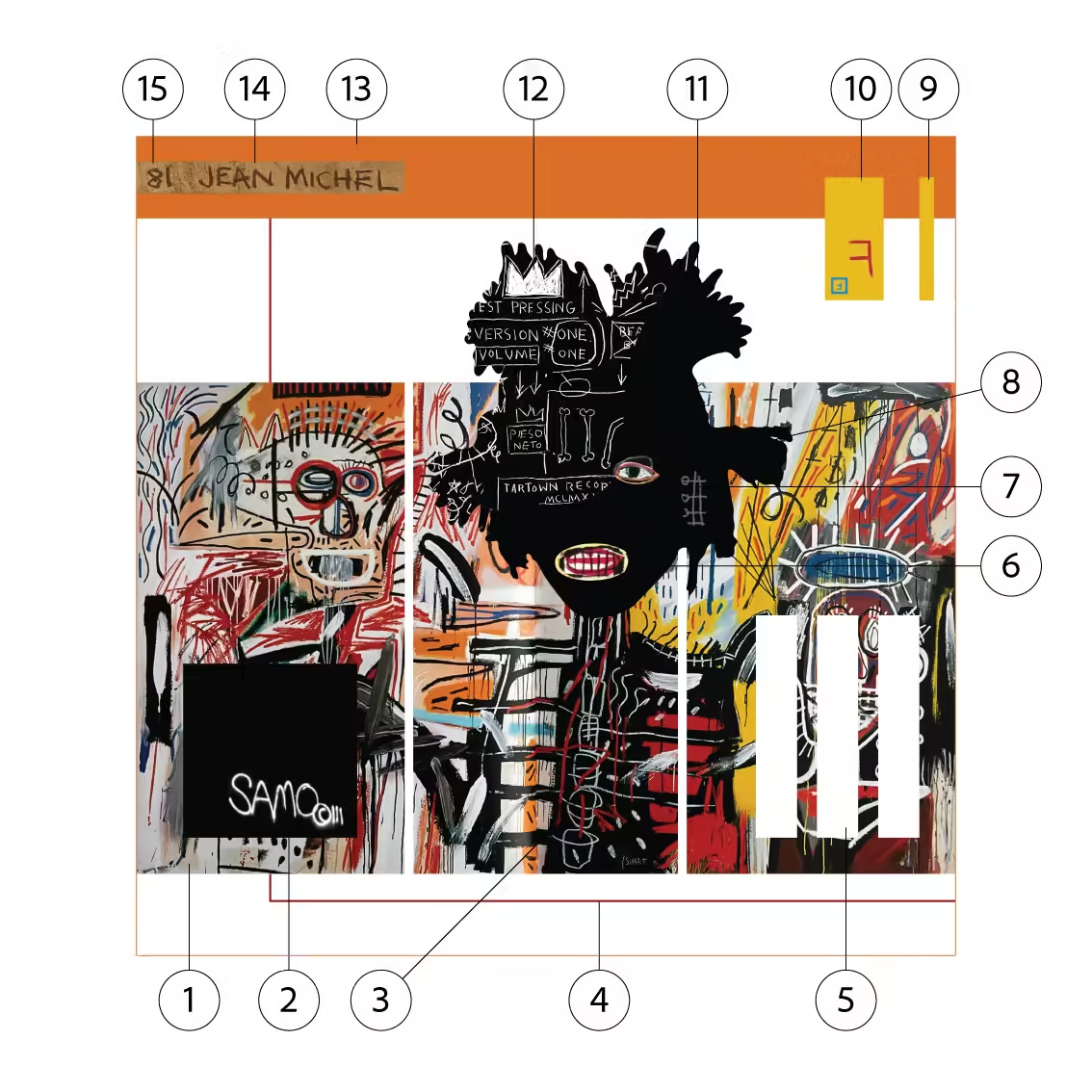For many years, I focused solely on the artists I knew and loved. However, after creating my piece For The Love of Frida, I realised that the more I learned about an artist, the more I understood and appreciated their process and the deeper meaning behind their work. This revelation has significantly broadened my perspective on the art world. I’ve been reading and researching more than ever, and this ongoing exploration constantly influences my work.
Jean-Michel Basquiat was one of the artists who initially faded into the shadows of other artists I admired. That changed when I encountered his piece Philistines. The bold colours and erratic brushstrokes resonated with me during a time when my personal life felt chaotic. This experience led me to dive deeply into Basquiat’s work, culminating in an homage portrait to celebrate him and his contributions to art.
Born in 1960s New York to a Haitian father and an American mother of Puerto Rican descent, Basquiat’s early life was steeped in culture, social prejudices, and physical hardships, including a car accident he suffered as a child. He was also exposed to the challenges of mental health and the struggle for basic survival. It’s no surprise that by the age of 15, he embarked on a path of rebellion, a young boy searching for his place in the world.
From the books I’ve read and documentaries I’ve watched, I’ve learned that Basquiat was a shy, introverted figure who constantly sought to be seen. His observations and experiences of the injustices around him – whether related to wealth and poverty, racial inequality, or the power dynamics of institutions – were powerfully expressed through his graffiti and artwork. This was his voice.
Basquiat’s work is raw, honest, and tribal. While it may seem somewhat childlike (he once said, “I like kids’ work more than work by real artists any day.”), every element has purpose and meaning. He painted poetry through visual thoughts, symbols, and text – a stream of consciousness, almost.
Homage to Basquiat is a graphic collage portrait that celebrates some of my favourite aspects of his work, reinterpreted in my style. The following diagram shows my own stream of consciousness:

1 – Basquiat’s Philistines, 1982
Philistine means a person who is ‘unreceptive’ and dismissive towards cultures and the arts. In this piece, the black skeletal figure central to the piece is stabbing the white figure, possibly symbolising the struggle and unfairness of the power structures within the art world. Basquiat’s emotions are evident in his use of strongly contrasting colours and chaotic brushstrokes.
I chose this piece because it was so powerful. My interpretation of Philistines is that even today, being a selling artist is just as challenging as it was during Basquiat’s time. Nothing has changed. Celebrities with little to no artistic background can have an exhibition in a well-known art establishment because of who they are. What about genuine artists who have worked their whole lives yet still struggle to sell one piece, let alone have exhibition space? How is that fair?
2 – SAMO
‘SAMO’, which means ‘Same Old Shit‘, was a graffiti tag belonging to Basquiat and his friend Al Diaz. It became an iconic symbol in Basquiat’s work and is literally where it all began for him.
3 – Skeletal Figure
When Basquiat was young, he had a car accident and hospitalised for some time. To occupy him, his mum gave him the book Gray’s Anatomy, which instilled a lifelong fascination with the workings of the human body. Skeletons and skulls are very much evident in nearly all his work.
4 – The Red Line
Even though Basquiat’s work was all brushwork, I wanted to confine his portrait within the solid red line to symbolise the constraints of the art establishment.
5 – Three Vertical Lines
In Henry Dreyfuss’s Symbol Sourcebook: An Authoritative Guide To International Graphic Symbols, 1984, which Basquiat often referred to, three vertical lines mean: ‘This is not a safe place.’ Another example of Basquiat’s visual interpretation of social injustice.
6 – Mouth
Detail from Basquiat’s Self-Portrait as a Heel, 1982
7 – Musical Detail
Detail taken from Basquiat’s 1983 painting Horn Players demonstrating his love for Jazz and Jazz musicians.
8 – Eye
Detail from Basquiat’s Self-Portrait as a Heel (Part Two), 1982
9 – Yellow Blocks
Detail from Basquiat’s Grillo, 1984. I chose to do the yellow blocks rigid to connect with the red line and what I chose for it to represent.
10 – Reference to Andy Warhol
Detail from Basquiat and Warhol’s Bananas, 1984/5 collaboration piece. Andy Warhol was Basquiat’s friend and mentor and played an extremely significant role in his life. So much so that when Andy Warhol died, Basquiat’s mental health declined.
11 – Portrait Outline
Basquiat had many different hairstyles. This particular one is what makes him instantly recognisable.
12 – The Crown
Basquiat’s crown is an iconic symbol in the art world and is instantly recognisable with three possible meanings:
- A celebration and nod to those he admired
- Representing his ambition to be famous
- Basquiat sees himself as a King
13 – Orange Block
Detail from Basquiat’s Sans Titre (de al série II Blue Ribbon Paintings), 1984
14 – Jean Michel
Detail from Basquiat’s Crowns (Peso Neto), 1981. There are so many variations of Basquiat’s signature, it was ever-changing as he evolved as an artist. I chose this one as it seems more personal.
15 – 81
Detail from Basquiat’s Crowns (Peso Neto), 1981. The year in which I was born.
Basquiat is a profound source of inspiration for me. The passion and courage he displayed in visually representing the world’s injustices were truly admirable. He once said, “I’m not a real person. I’m a legend.” He wasn’t wrong. Sadly, Basquiat didn’t receive the recognition and legendary status he deserved during his lifetime — what a shame.
My Homage To Basquiat will be exhibited with Expo Metro in Milan from October 26th to 27th.